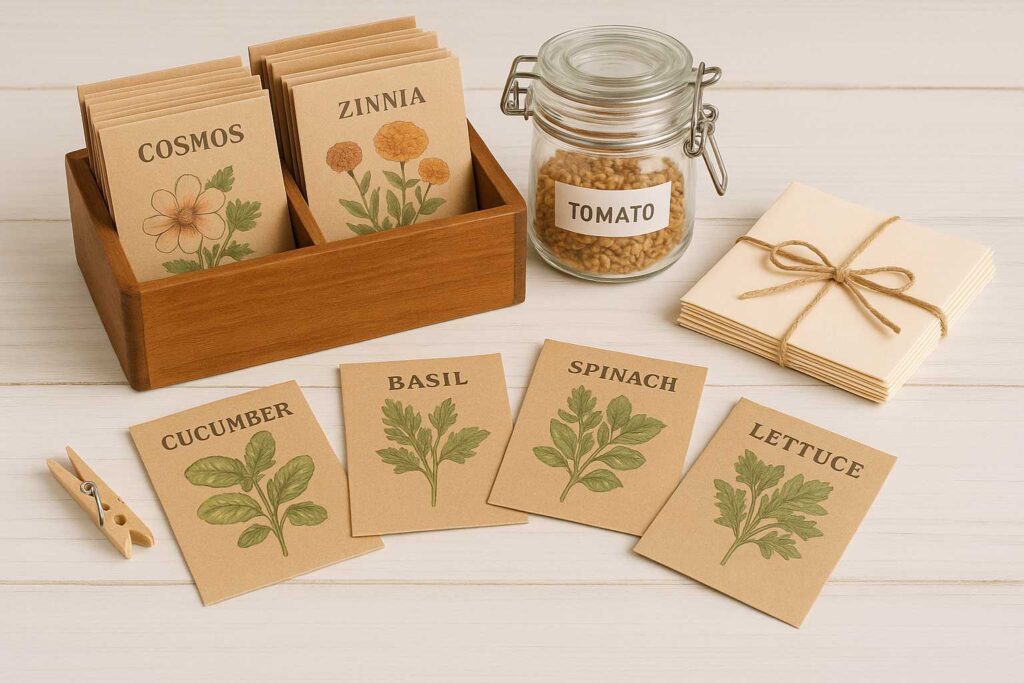Simple, creative ways to keep your garden seeds sorted, safe, and ready for planting
If you’ve ever found a mystery packet of seeds at the bottom of a basket—or wondered whether your three-year-old parsley seeds are still good—you’re not alone. As gardeners, we tend to collect, save, and squirrel away seeds with the best of intentions… and then misplace them.
This post is your go-to guide for labeling, organizing, and storing both store-bought packets and home-saved seeds—so you can plant with confidence (and maybe even find that calendula you loved two years ago).
Labeling Your Seeds
Store-Bought Packets:
These usually come with great info already printed—variety name, planting depth, harvest window. Still, it’s helpful to:
Circle or highlight the expiration year
Add notes like “germinates slowly,” “do well in partial shade,” or “save seeds next year!”
Home-Saved Seeds:
Make your labels simple but specific. Include:
Plant name + variety (e.g., Tomato – Cherokee Purple)
Date saved (Month & Year)
Where it was grown (optional but helpful)
Notes on growth habits or pollination (e.g., “crossed with Sungold?” or “grew well in sandy soil”)
Tools for labeling:
Waterproof garden marker or pencil (pen can fade)
Pre-cut seed envelopes, coin envelopes, or recycled tea envelopes
Masking tape or washi tape for jars and bags
How to Organize Your Seeds
Accordion File Folder
Use labeled tabs by month or season: “Fall”, “Spring”, “Anytime”
Great for those who want a tidy, visual system
Recipe Box or Photo Box
Add index cards as dividers by plant type: “Herbs,” “Greens,” “Roots,” “Flowers”
A tactile, analog solution that’s great for small collections
Toolbox or Fishing Tackle Box
Great for gardeners with lots of saved seeds in baggies or jars
Each compartment can be labeled for fast access
Seed Binder
Use trading card sleeves or small zip sleeves to display and flip through your seed collection
Ideal for visual learners or seed swappers
The “Old Cookie Tin” Method
Toss them in and dig around when you’re inspired (no judgment here!)
Works best when paired with a seasonal planting calendar
How to Store Seeds for Longevity
Seeds are living things, and how you store them directly affects their viability. Follow these rules to keep your seeds healthy between seasons.
Cool, Dry, Dark
Aim for consistent conditions: pantry, cupboard, or interior closet
Skip garages and sheds in Florida—they get too hot and humid
Use Airtight Containers
Mason jars with tight lids
Resealable mylar or zip-top bags with desiccants (like rice or silica packets)
Optional: Fridge Storage
Store envelopes in a jar or container to protect from condensation
Only do this if you won’t be opening it frequently (temp shifts = moisture risk)
Track Seed Viability
Here’s a quick rule of thumb:
Lettuce, radish, tomato, and cucumber: ~4–5 years
Carrots, onions, parsley: ~1–2 years
Beans, peas, and corn: ~2–3 years
Not sure if they’re still good? Do a germination test: place a few seeds between moist paper towels, seal in a bag, and check for sprouts in 3–10 days.
Seed Storage as a Ritual
Organizing your seeds can be part of your seasonal rhythm—something you do while sipping tea, planning next season’s garden, or teaching a child the names of what you grow.
Your seed system doesn’t have to be perfect. It just has to make sense to you. And if you misplace a packet? That’s okay too. Sometimes the best discoveries are the ones that sprout unexpectedly.
Ready to Refresh Your Seed Setup?
Want help designing your own planting calendar, garden layout, or seasonal sowing guide for Central Florida? I offer one-on-one coaching and seed-saving workshops.
Contact me here to schedule a consultation.
Happy sorting,
Larissa
Stepping Stone Garden Coach

